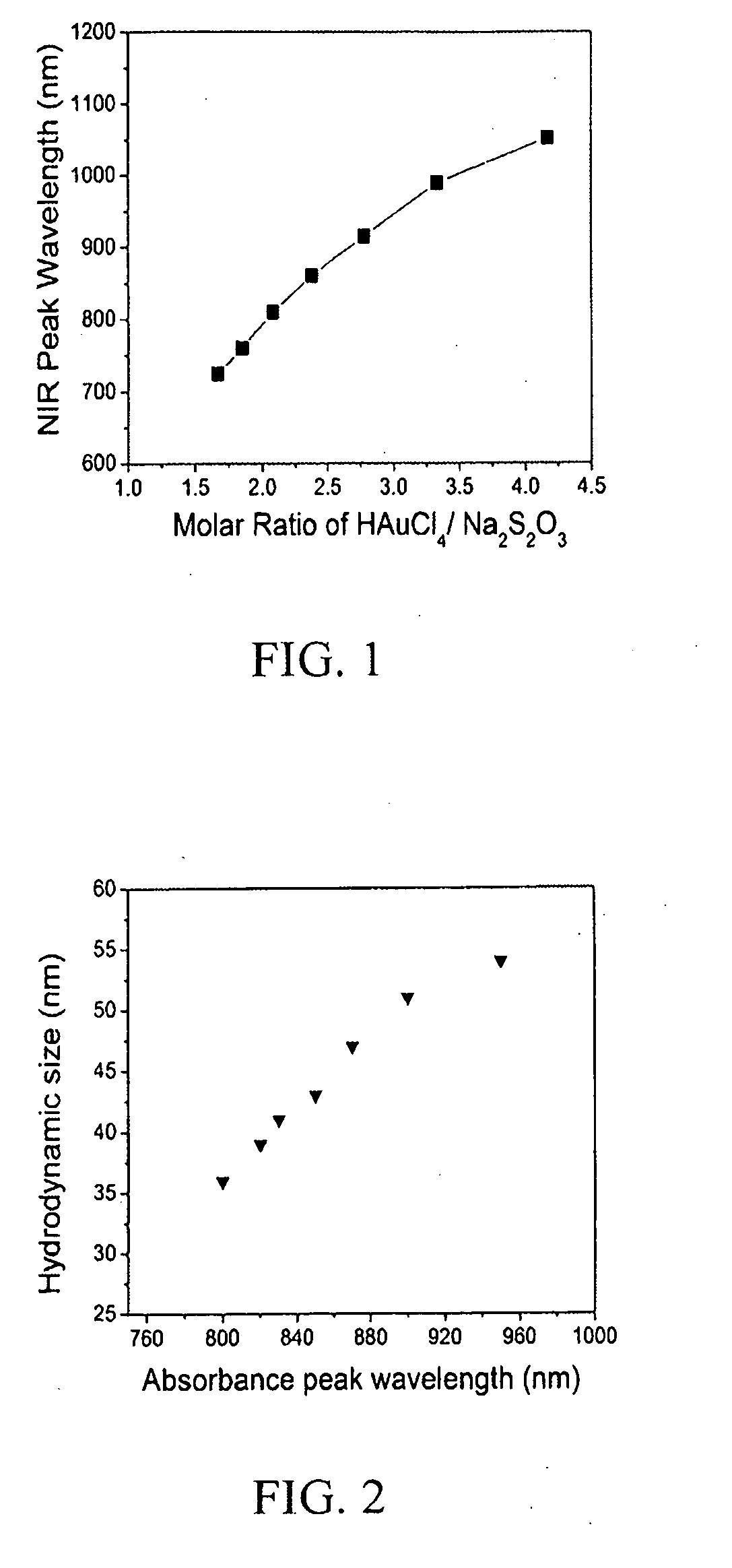Diagnostic and therapeutic nanoparticles
- Summary
- Abstract
- Description
- Claims
- Application Information
AI Technical Summary
Benefits of technology
Problems solved by technology
Method used
Image
Examples
example 1
[0047]This example demonstrates the preparation of a first embodiment of the hybrid nanoparticle of the present invention. This hybrid nanoparticle includes a GGS nanoparticle with an absorbance peak at about 820 nm and a chitosan coating and has an isoelectric point of about 7.7. The procedure to prepare this embodiment of the present invention is as follows.
[0048]GGS nanoparticles are prepared by the reaction of sodium thiosulfate and chloroauric acid. 54 ml 3 mM Na2S2O3 is added to 150 ml 2 mM HAuCl4, and vortexed for about 1 minute. The solution is then left to react for about 45 minutes. The nanoparticle concentration is around 3.5 to 4 OD.
[0049]Low molecular weight (“LMW”) chitosan, such as that provided by Sigma-Aldrich, is used for the coating of GGS nanoparticles. The chitosan solution is prepared by dissolving 1.0 g LMW chitosan in 100 ml 0.7 wt. % acetic acid solution.
[0050]The chitosan is added to the GGS nanoparticle solution about 45 minutes after the mixing of chloroa...
example 2
[0053]This example demonstrates the preparation of a second embodiment of the hybrid nanoparticle of the present invention. This hybrid nanoparticle includes a GGS nanoparticle with an absorbance peak at about 820 nm and a TIBA-modified chitosan coating and has an isoelectric point of about 7.7. The procedure to prepare this embodiment of the present invention is as follows.
[0054]GGS nanoparticles are prepared by the reaction of sodium thiosulfate and chloroauric acid. 54 ml 3 mM Na2S2O3 is added to 150 ml 2 mM HAuCl4, and vortexed for about 1 minute. The solution is then left to react for about 45 minutes. The nanoparticle concentration is around 3.5 to 4 OD.
[0055]TIBA-modified chitosan is used for the coating of GGS nanoparticles. The TIBA-modified chitosan solution is prepared by dissolving 0.4 g LMW chitosan in 40 ml 0.7 wt. % acetic acid solution. The chitosan solution is then dialysed in DI water for 2 to 6 days. The pH of the chitosan solution increases from about 4.0 to abou...
example 3
[0059]This example demonstrates the preparation of a third embodiment of the hybrid nanoparticle of the present invention. This hybrid nanoparticle includes a GGS nanoparticle with an absorbance peak at about 850 nm and a blended chitosan / CMCS coating and has an isoelectric point of about 7.1. The procedure to prepare this embodiment of the present invention is as follows.
[0060]GGS nanoparticles are prepared by the reaction of sodium thiosulfate and chloroauric acid. 28.5 ml 3 mM Na2S2O3 is added to 150 ml 2 mM HAuCl4, and vortexed for about 1 minute. The solution is then left to react for about 45 minutes. The nanoparticle concentration is around 3.5 to 4 OD.
[0061]A blend of LMW chitosan and CMCS is used for the coating of GGS nanoparticles. The chitosan solution is prepared by dissolving 1.0 g LMW chitosan in 100 ml 0.7 wt. % acetic acid solution. CMCS is prepared by dissolving 15 g sodium hydroxide in a mixture solution of 80 ml isopropanol and 20 ml DI water. 10 g LMW chitosan i...
PUM
| Property | Measurement | Unit |
|---|---|---|
| Diameter | aaaaa | aaaaa |
| Diameter | aaaaa | aaaaa |
| Diameter | aaaaa | aaaaa |
Abstract
Description
Claims
Application Information
 Login to View More
Login to View More - R&D
- Intellectual Property
- Life Sciences
- Materials
- Tech Scout
- Unparalleled Data Quality
- Higher Quality Content
- 60% Fewer Hallucinations
Browse by: Latest US Patents, China's latest patents, Technical Efficacy Thesaurus, Application Domain, Technology Topic, Popular Technical Reports.
© 2025 PatSnap. All rights reserved.Legal|Privacy policy|Modern Slavery Act Transparency Statement|Sitemap|About US| Contact US: help@patsnap.com

